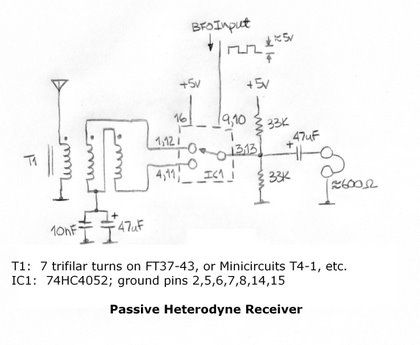Using a full-size antenna and a reasonably sensitive headphone, this simple switching mixer will produce an amazing abundance of signals on 80m.
I used a 74HC4052 CMOS multiplexer for the simple reason that I found one in my junkbox. Almost any similar CMOS switch capable of working at this frequency would be equally useful. Likewise, the input balun could be wound on virtually any low(ish)-loss, moderately high-permeability core. Aim for a minimum of 20uH, or so, of inductance per winding. I stole the square-wave BFO from my current transmitter which uses a VXO circuit similar to the one used in my Snowflake. Of course, any number of simple square-wave oscillators - built around CMOS or TTL logic gates - would do as well.
4/5/08
Please bear in mind the mixer output impedance is roughly the same as the source impedance; typically, 50 Ohms. Directly coupling a pair of 600 Ohm headphones to the mixer - as I show in the schematic - will result in an insertion power loss of roughly 5dB. There are a number of ways to improve the impedance match to the headphones you choose to use. An audio transfomer between the mixer output and the headphones is an obvious possibility. My solution was to alter the primary/seconday turns-ratio of the input balun transformer in order to raise the mixer working impedance to approximately 600 Ohms. For this, I used a turns-ratio of 1 to 3.5.
In the past ten days I've used this receiver to make a total of twenty contacts on 80m. I particularly enjoyed working Paul, VE1DY, who was running an Elecraft K2 at 4W, and Bill, W9VC, using his Drake 2NT with an output power of 66W.
